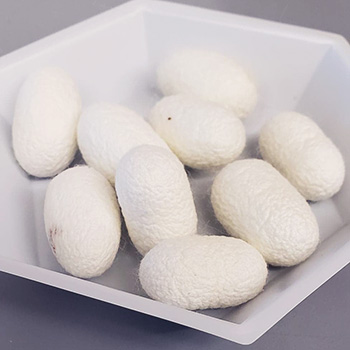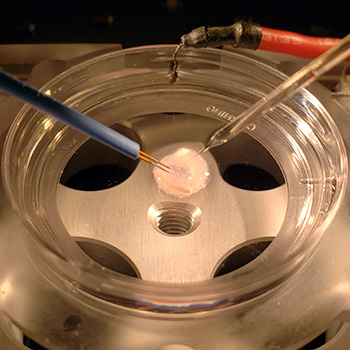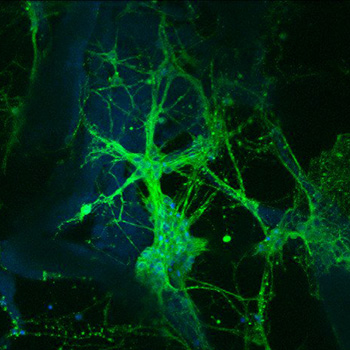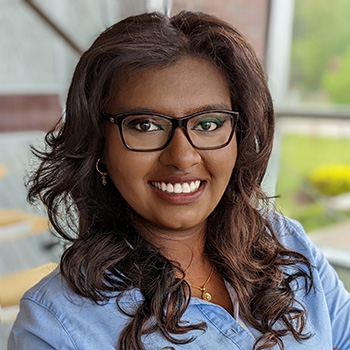Search for academic programs, residence, tours and events and more.
Aug. 22, 2023
While the world grapples with dazzling and disturbing developments in artificial intelligence, scientists are perfecting a form of biological intelligence that may help to cure disease, develop life-saving drugs, and truly understand how humans think and behave. In essence, they are building miniaturized brains from scratch to emulate the central nervous system.
Two Wilfrid Laurier University professors are working at the forefront of this emerging technology. Nirosha Murugan and Nicolas Rouleau recently joined Laurier’s Department of Health Sciences, drawn by the university’s interdisciplinary approach to medical advancement. In an effort to consolidate existing knowledge and inspire future research, they published a paper in Nature Reviews Bioengineering highlighting various bioengineered models of the central nervous system and their range of potential applications.
“There’s an entire field called neural tissue engineering which uses different techniques to create these miniaturized brain tissues, usually to understand disease processes,” says Rouleau. “For example, the most popular form in the world right now is called a neural organoid. By culturing human skin cells, a prototypical central nervous system forms that even displays brainwaves, just like us.”
In their paper, Murugan and Rouleau compare and contrast the benefits and limitations of existing model systems.



“We hope experts across the engineering and regenerative medicine communities come together and use this resource to address the big questions, like how to treat Alzheimer’s disease or traumatic brain injury,” says Rouleau. “As opposed to studying these pathologies in humans and having to wait 30 years, we can study them in a dish and see results within a few months. It greatly accelerates our ability to develop treatments.”
Murugan and Rouleau are keen to tackle the “big questions” themselves, arriving at Laurier with impressive track records of research success.
Murugan is uniquely diverse in her skillset, combining molecular biology with tissue biophysics. Following her appointment as the Canada Research Chair in Tissue Biophysics at Algoma University, she was welcomed to Laurier as a Faculty of Science Distinguished Research Chair.
“I use physics to understand how cells and tissues communicate,” says Murugan. “For example, what triggers a healthy cell to become cancerous? Why can’t healthy cells communicate with pathological cells to get them back to how they used to be?”
Just as chemicals instruct cells to divide and grow, so do biophysical signals, such as magnetic and electrical signals, that naturally exist within a cell’s microenvironment. Murugan’s research uncovered these signals as a determinant of cell health, and now she is manipulating them to treat diseases.

"I will be using some of these neural models to study neuroblastoma, a cancer that forms in nerve cells and largely affects young children."
Nirosha Murugan, Faculty of Science Distinguished Research Chair
While completing her PhD in biomolecular sciences, Murugan developed a tool using electromagnetic fields to stop the spread of cancer. It can specifically target cancerous cells to stop a tumour from growing while avoiding damage to healthy cells. She built on her discovery during a postdoctoral fellowship at Tufts University in Boston where she joined a lab examining cell communication through electrical signals.
“We thought, ‘If cancers divide in a very abnormal way, are there other cells in the body that do the same thing and are equally as plastic?’” says Murugan. “That led us to consider stem cells.”
Murugan and her colleagues developed a patented technology that uses stem cells to regrow limbs. Their study, in which they enabled African clawed frogs to regenerate leglike limbs, received international media coverage and was heralded as a key advancement in regenerative medicine.
Murugan’s innovation continues at Laurier, where her research program is focused on cancer reprogramming. She is using light magnetics and electrical fields to revert cancerous cells back to a healthy state.
Rouleau brings a similarly multidisciplinary perspective to his research as a behavioural neuroscientist and bioengineer. He is fascinated by brain structure and function.
“I want to understand what processes at the cellular and tissue levels give rise to all of these brain functions that we care about, like problem solving and decision-making, along with our thoughts, emotions and behaviours,” says Rouleau.
As a postdoctoral fellow at Tufts University, Rouleau began applying principles of psychology to bioengineered brain tissues.
“These are miniaturized neural networks that are only a couple of millimetres across, yet have millions of cells within them that signal to each other just like our human brains,” says Rouleau.

"We can study pathologies in a dish and see results within a few months. It greatly accelerates our ability to develop treatments."
Nicolas Rouleau, assistant professor, Health Sciences
At Laurier, Rouleau plans to pair bioengineered brain tissues with robots to explore cognition.
“The robot will receive input from the tissue and then, through the use of sensors, the robot sends feedback to the tissue,” says Rouleau. “That loop of sensory and motor feedback builds capacity for the tissue to make and adjust decisions based on what’s happening in its environment. From that, we can learn a lot about what cognition really is at a fundamental level.”
In his career to date, which has included an assistant professorship at Algoma University and a teaching fellowship at Harvard University, Rouleau has employed similar technologies to investigate the roots of major brain diseases such as Alzheimer’s, Parkinson’s and traumatic brain injury.
Rouleau says bioengineered brain tissues are a superior model to the brains of animals that science has traditionally relied on because their components can be stimulated, directed and destroyed without causing harm to living organisms. Additionally, because they can be built from human tissues, bioengineered brains more accurately reflect human chemistry and disease response.
Using bioengineered brain tissue to study disease is where Rouleau and Murugan’s research interests intersect. As communicated in their Nature paper, they both see huge potential for neural tissue engineering to help improve cellular regeneration and accelerate drug discovery.
“I will be using some of these neural models to study neuroblastoma, a cancer that forms in nerve cells and largely affects young children,” says Murugan. “We can insert cancer into brain tissue to observe how the molecular mechanisms develop and the communication methods between cancer and neural tissue. Another avenue I’m looking at is how the nerves in our arms and hands link up to our brains and how damages to those nerves affect the central nervous system.”

Murugan is also partnering with Rouleau to develop diagnostic tools to non-invasively record human brain activity. Their spirit of collaboration is mirrored by their Laurier colleagues and they are excited to help grow the university’s biomedical engineering infrastructure.
“The thing that is really attractive about Laurier’s Health Sciences department is that we have both molecular scientists and societal-focused researchers, and the combination of the two means that we can discuss ideas across disciplinary boundaries,” says Rouleau. “We are all working together to address human health and we’re very supportive of each other.”
“I was also drawn to Laurier because of its graduate students and their interdisciplinary training,” says Murugan. “I wouldn’t be here if I didn’t have a mentor who fostered my creativity, and I’d like to bring students who are equally as creative on this journey with us.”